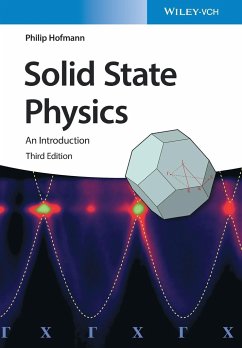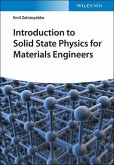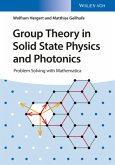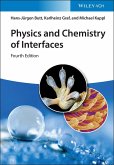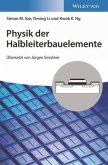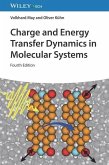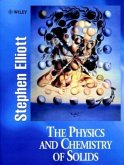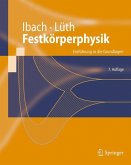Philip Hofmann
Solid State Physics
Philip Hofmann
Solid State Physics
- Broschiertes Buch
- Merkliste
- Auf die Merkliste
- Bewerten Bewerten
- Teilen
- Produkt teilen
- Produkterinnerung
- Produkterinnerung
A concise introduction to solid state physics covering all relevant fundamental phenomena and concepts and advanced topics such as low-dimensional materials, magnetism and superconductivity. Now with more problems and - new! - multiple-choice problems for self-testing.
Andere Kunden interessierten sich auch für
![Introduction to Solid State Physics for Materials Engineers Introduction to Solid State Physics for Materials Engineers]() Emil ZolotoyabkoIntroduction to Solid State Physics for Materials Engineers41,99 €
Emil ZolotoyabkoIntroduction to Solid State Physics for Materials Engineers41,99 €![Group Theory in Solid State Physics and Photonics Group Theory in Solid State Physics and Photonics]() Wolfram HergertGroup Theory in Solid State Physics and Photonics98,99 €
Wolfram HergertGroup Theory in Solid State Physics and Photonics98,99 €![Physics and Chemistry of Interfaces Physics and Chemistry of Interfaces]() Hans-Jürgen ButtPhysics and Chemistry of Interfaces53,99 €
Hans-Jürgen ButtPhysics and Chemistry of Interfaces53,99 €![Physik der Halbleiterbauelemente Physik der Halbleiterbauelemente]() Simon M. SzePhysik der Halbleiterbauelemente99,90 €
Simon M. SzePhysik der Halbleiterbauelemente99,90 €![Charge and Energy Transfer Dynamics in Molecular Systems Charge and Energy Transfer Dynamics in Molecular Systems]() Volkhard MayCharge and Energy Transfer Dynamics in Molecular Systems123,99 €
Volkhard MayCharge and Energy Transfer Dynamics in Molecular Systems123,99 €![The Physics and Chemistry of Solids The Physics and Chemistry of Solids]() Stephen ElliottThe Physics and Chemistry of Solids93,99 €
Stephen ElliottThe Physics and Chemistry of Solids93,99 €![Festkörperphysik Festkörperphysik]() Harald IbachFestkörperphysik79,99 €
Harald IbachFestkörperphysik79,99 €-
-
-
A concise introduction to solid state physics covering all relevant fundamental phenomena and concepts and advanced topics such as low-dimensional materials, magnetism and superconductivity. Now with more problems and - new! - multiple-choice problems for self-testing.
Produktdetails
- Produktdetails
- Verlag: Wiley-VCH
- Artikelnr. des Verlages: 1141410 000
- 3. Aufl.
- Seitenzahl: 288
- Erscheinungstermin: 6. Juni 2022
- Englisch
- Abmessung: 244mm x 170mm x 16mm
- Gewicht: 540g
- ISBN-13: 9783527414109
- ISBN-10: 352741410X
- Artikelnr.: 63545351
- Herstellerkennzeichnung
- Wiley-VCH GmbH
- Boschstr. 12
- 69469 Weinheim
- wiley.buha@zeitfracht.de
- www.wiley-vch.de
- Verlag: Wiley-VCH
- Artikelnr. des Verlages: 1141410 000
- 3. Aufl.
- Seitenzahl: 288
- Erscheinungstermin: 6. Juni 2022
- Englisch
- Abmessung: 244mm x 170mm x 16mm
- Gewicht: 540g
- ISBN-13: 9783527414109
- ISBN-10: 352741410X
- Artikelnr.: 63545351
- Herstellerkennzeichnung
- Wiley-VCH GmbH
- Boschstr. 12
- 69469 Weinheim
- wiley.buha@zeitfracht.de
- www.wiley-vch.de
Philip Hofmann studied physics at the Free University, Berlin and did his PhD research at the Fritz-Haber-Institute of the Max Planck Society, also in Berlin. He stayed at the Oak Ridge National Laboratory, USA, as a Feodor Lynen Fellow of the Alexander von Humboldt Foundation. In 1998, he moved to the University of Aarhus, Denmark, where he is associated with the Synchrotron Radiation Source and the Interdisciplinary Nanoscience Center (iNANO). His research is primarily focused on the electronic structure of solids and their surfaces.
Preface
CRYSTAL STRUCTURES
General Description of Crystal Structures
Some Important Crystal Structures
Crystal Structure Determination
Further Reading
Discussion and Problems
BONDING IN SOLIDS
Attractive and Repulsive Forces
Ionic Bonding
Covalent Bonding
Metallic Bonding
Hdrogen Bonding
van der Waals Bonding
Further Reading
Discussion and Problems
MECHANICAL PROPERTIES
Elastic Deformation
Plastic Deformation
Fracture
Further Reading
Discussion and Problems
THERMAL PROPERTIES OF THE LATTICE
Lattice Vibrations
Heat Capacity of the Lattice
Thermal Conductivity
Thermal Expansion
Allotropic Phase Transitions and Melting
Further Reading
Discussion and Problems
ELECTRONIC PROPERTIES OF METALS: CLASSICAL APPROACH
Basic Assumptions of the Drude Model
Results from the Drude Model
Shortcomings of the Drude Model
Further Reading
Discussion and Problems
ELECTRONIC PROPERTIES OF SOLIDS: QUANTUM MECHANICAL APPROACH
The Idea of Energy Bands
Free Electron Model
The General Form of the Electronic States
Nearly Free Electron Model
Tight-Binding Model
Energy Bands in Real Solids
Transport Properties
Brief Review of Some Key Ideas
Further Reading
Discussion and Problems
SEMICONDUCTORS
Intrinsic Semiconductors
Doped Semiconductors
Conductivity and Semiconductors
Semiconductor Devices
Further Reading
Discussion and Problems
MAGNETISM
Macroscopic Description
Quantum Mechaical Description of Magnetism
Paramagnetism and Diamagnetism in Atoms
Weak Magnetism in Solids
Magnetic Ordering
Further Reading
Discussion and Problems
DIELECTRICS
Macroscopic Description
Microscopic Polarization
The Local Field
Frequency Dependence of the Dielectric Constant
Other Effects
Further Reading
Discussion and Problems
SUPERCONDUCTIVITY
Basic Experimental Facts
Some Theoretical Aspects
Experimental Detection of the Gap
Coherence of the Superconducting State
Type I and Type II Superconductors
High-Temperature Superconductivity
Concluding Remarks
Further Reading
Discusson and Problems
FINITE SOLIDS AND NANOSTRUCTURES
Quantum Confinement
Surfaces and Interfaces
Magnetism on the Nanoscale
Further Reading
Discussion and Problems
APPENDIX
Explicit Forms of Vector Operations
Differential Form of the Maxwell Equations
Maxwell Equations in Matter
CRYSTAL STRUCTURES
General Description of Crystal Structures
Some Important Crystal Structures
Crystal Structure Determination
Further Reading
Discussion and Problems
BONDING IN SOLIDS
Attractive and Repulsive Forces
Ionic Bonding
Covalent Bonding
Metallic Bonding
Hdrogen Bonding
van der Waals Bonding
Further Reading
Discussion and Problems
MECHANICAL PROPERTIES
Elastic Deformation
Plastic Deformation
Fracture
Further Reading
Discussion and Problems
THERMAL PROPERTIES OF THE LATTICE
Lattice Vibrations
Heat Capacity of the Lattice
Thermal Conductivity
Thermal Expansion
Allotropic Phase Transitions and Melting
Further Reading
Discussion and Problems
ELECTRONIC PROPERTIES OF METALS: CLASSICAL APPROACH
Basic Assumptions of the Drude Model
Results from the Drude Model
Shortcomings of the Drude Model
Further Reading
Discussion and Problems
ELECTRONIC PROPERTIES OF SOLIDS: QUANTUM MECHANICAL APPROACH
The Idea of Energy Bands
Free Electron Model
The General Form of the Electronic States
Nearly Free Electron Model
Tight-Binding Model
Energy Bands in Real Solids
Transport Properties
Brief Review of Some Key Ideas
Further Reading
Discussion and Problems
SEMICONDUCTORS
Intrinsic Semiconductors
Doped Semiconductors
Conductivity and Semiconductors
Semiconductor Devices
Further Reading
Discussion and Problems
MAGNETISM
Macroscopic Description
Quantum Mechaical Description of Magnetism
Paramagnetism and Diamagnetism in Atoms
Weak Magnetism in Solids
Magnetic Ordering
Further Reading
Discussion and Problems
DIELECTRICS
Macroscopic Description
Microscopic Polarization
The Local Field
Frequency Dependence of the Dielectric Constant
Other Effects
Further Reading
Discussion and Problems
SUPERCONDUCTIVITY
Basic Experimental Facts
Some Theoretical Aspects
Experimental Detection of the Gap
Coherence of the Superconducting State
Type I and Type II Superconductors
High-Temperature Superconductivity
Concluding Remarks
Further Reading
Discusson and Problems
FINITE SOLIDS AND NANOSTRUCTURES
Quantum Confinement
Surfaces and Interfaces
Magnetism on the Nanoscale
Further Reading
Discussion and Problems
APPENDIX
Explicit Forms of Vector Operations
Differential Form of the Maxwell Equations
Maxwell Equations in Matter
Preface
CRYSTAL STRUCTURES
General Description of Crystal Structures
Some Important Crystal Structures
Crystal Structure Determination
Further Reading
Discussion and Problems
BONDING IN SOLIDS
Attractive and Repulsive Forces
Ionic Bonding
Covalent Bonding
Metallic Bonding
Hdrogen Bonding
van der Waals Bonding
Further Reading
Discussion and Problems
MECHANICAL PROPERTIES
Elastic Deformation
Plastic Deformation
Fracture
Further Reading
Discussion and Problems
THERMAL PROPERTIES OF THE LATTICE
Lattice Vibrations
Heat Capacity of the Lattice
Thermal Conductivity
Thermal Expansion
Allotropic Phase Transitions and Melting
Further Reading
Discussion and Problems
ELECTRONIC PROPERTIES OF METALS: CLASSICAL APPROACH
Basic Assumptions of the Drude Model
Results from the Drude Model
Shortcomings of the Drude Model
Further Reading
Discussion and Problems
ELECTRONIC PROPERTIES OF SOLIDS: QUANTUM MECHANICAL APPROACH
The Idea of Energy Bands
Free Electron Model
The General Form of the Electronic States
Nearly Free Electron Model
Tight-Binding Model
Energy Bands in Real Solids
Transport Properties
Brief Review of Some Key Ideas
Further Reading
Discussion and Problems
SEMICONDUCTORS
Intrinsic Semiconductors
Doped Semiconductors
Conductivity and Semiconductors
Semiconductor Devices
Further Reading
Discussion and Problems
MAGNETISM
Macroscopic Description
Quantum Mechaical Description of Magnetism
Paramagnetism and Diamagnetism in Atoms
Weak Magnetism in Solids
Magnetic Ordering
Further Reading
Discussion and Problems
DIELECTRICS
Macroscopic Description
Microscopic Polarization
The Local Field
Frequency Dependence of the Dielectric Constant
Other Effects
Further Reading
Discussion and Problems
SUPERCONDUCTIVITY
Basic Experimental Facts
Some Theoretical Aspects
Experimental Detection of the Gap
Coherence of the Superconducting State
Type I and Type II Superconductors
High-Temperature Superconductivity
Concluding Remarks
Further Reading
Discusson and Problems
FINITE SOLIDS AND NANOSTRUCTURES
Quantum Confinement
Surfaces and Interfaces
Magnetism on the Nanoscale
Further Reading
Discussion and Problems
APPENDIX
Explicit Forms of Vector Operations
Differential Form of the Maxwell Equations
Maxwell Equations in Matter
CRYSTAL STRUCTURES
General Description of Crystal Structures
Some Important Crystal Structures
Crystal Structure Determination
Further Reading
Discussion and Problems
BONDING IN SOLIDS
Attractive and Repulsive Forces
Ionic Bonding
Covalent Bonding
Metallic Bonding
Hdrogen Bonding
van der Waals Bonding
Further Reading
Discussion and Problems
MECHANICAL PROPERTIES
Elastic Deformation
Plastic Deformation
Fracture
Further Reading
Discussion and Problems
THERMAL PROPERTIES OF THE LATTICE
Lattice Vibrations
Heat Capacity of the Lattice
Thermal Conductivity
Thermal Expansion
Allotropic Phase Transitions and Melting
Further Reading
Discussion and Problems
ELECTRONIC PROPERTIES OF METALS: CLASSICAL APPROACH
Basic Assumptions of the Drude Model
Results from the Drude Model
Shortcomings of the Drude Model
Further Reading
Discussion and Problems
ELECTRONIC PROPERTIES OF SOLIDS: QUANTUM MECHANICAL APPROACH
The Idea of Energy Bands
Free Electron Model
The General Form of the Electronic States
Nearly Free Electron Model
Tight-Binding Model
Energy Bands in Real Solids
Transport Properties
Brief Review of Some Key Ideas
Further Reading
Discussion and Problems
SEMICONDUCTORS
Intrinsic Semiconductors
Doped Semiconductors
Conductivity and Semiconductors
Semiconductor Devices
Further Reading
Discussion and Problems
MAGNETISM
Macroscopic Description
Quantum Mechaical Description of Magnetism
Paramagnetism and Diamagnetism in Atoms
Weak Magnetism in Solids
Magnetic Ordering
Further Reading
Discussion and Problems
DIELECTRICS
Macroscopic Description
Microscopic Polarization
The Local Field
Frequency Dependence of the Dielectric Constant
Other Effects
Further Reading
Discussion and Problems
SUPERCONDUCTIVITY
Basic Experimental Facts
Some Theoretical Aspects
Experimental Detection of the Gap
Coherence of the Superconducting State
Type I and Type II Superconductors
High-Temperature Superconductivity
Concluding Remarks
Further Reading
Discusson and Problems
FINITE SOLIDS AND NANOSTRUCTURES
Quantum Confinement
Surfaces and Interfaces
Magnetism on the Nanoscale
Further Reading
Discussion and Problems
APPENDIX
Explicit Forms of Vector Operations
Differential Form of the Maxwell Equations
Maxwell Equations in Matter

